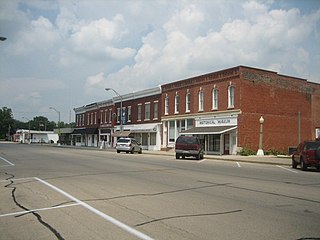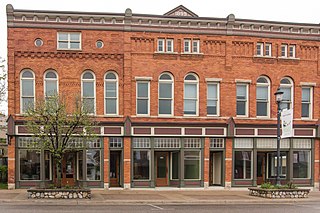
The Montgomery Building is the last surviving false-front structure and the oldest existing business building in the City of El Paso, Texas.

The Montgomery Building is the last surviving false-front structure and the oldest existing business building in the City of El Paso, Texas.
The Montgomery Building was built as the American El Paso, as opposed to a Mexican El Paso, underwent a great transformation from a dusty adobe village to a thriving city following the arrival of the railroad on May 13, 1881. The Southern Pacific Railroad had just arrived in El Paso and two other railroads were approaching the outskirts of the county. A great commercial building boom followed as lumber and brick structures, some two stories high, began replacing adobe ones. El Paso Street became a bustling center of commerce running from San Jacinto Plaza on San Francisco Street to the ferry landing at the Rio Grande. [1]
In 1882, just months after the Four Dead in Five Seconds Gunfight, William J. Montgomery (1833–1899) built this structure on a vacant lot between two buildings that were situated North and South of the property. Montgomery made use of the two buildings' existing walls, constructing only a roof, floor, front wall and back wall. He ran a new wall down the middle, creating two new addresses, 216 and 218 El Paso Street. [2]
The building was typical of western frontier architecture of the late 19th century. It featured a false front to make it appear taller and more like commercial buildings found in the East. Originally, the building housed a drug store and a book store.

The outward appearance of the Montgomery building was typical of those built in Western towns during the railroad boom of the late 19th century. Developers wanted railroad towns to look as much like eastern towns as possible so stone and lumber quickly replaced adobe and log as the primary building materials. Timber was scarce in El Paso but the railroad brought milled lumber, much of it from the Cloudcroft area. Railroads also brought pressed tin, cast iron, glass and hardware that were used to simulate styles popular in the eastern United States. [3] : 67–68
The one-part commercial building is a simple box with a decorated wood façade and cornice. The architectural style of small, pitched-roof buildings with false fronts created the commercial core of the new western towns during the mid-19th century.
The Montgomery building had one ground-level floor with a false front added to make the building appear taller. The false front was topped by a bracketed cornice typical of the Italianate style popular at the time. This created the impression that the building was larger and housed more businesses and people, similar to the main commercial streets found in eastern American towns. [3] : 70 In front of the original structure there was a wooden sidewalk covered by a wooden roof and hitching posts for horses. It is known exactly what the exterior of the Montgomery building looked like in 1882 from a photograph taken by F. Parker who documented many of the changes taking place in the city during that period. [4]

The two addresses have undergone many interior and exterior renovations over the years. They have housed drugstores, restaurants, shoemakers, and clothing stores. The building is now occupied by Dave’s A Pawn Shop and a clothing store. With the arrival of the automobile and the paving of streets, the wooden sidewalks, post, and roofs were removed and conventional sidewalks were constructed. [5] Today, the wooden facade of the building lies beneath a modern sign but the cornice is clearly visible. 216-218 S. El Paso Street is a classic example of western architecture from the boom era of the 1880s.
Situated on one of the past main commercial thoroughfares of the city, it continues to represent part of the rich frontier heritage of El Paso and is one of the few remaining structures from the original commercial district of the Old Western town of El Paso.
The addresses 216 and 218 S. El Paso St. have remained in continuous use for more than one hundred and twenty years making it the oldest surviving commercial structure in the City of El Paso.

The Main Street Historic District in Tampico, Illinois, United States is a historic district notable as home to the birthplace of Ronald Reagan. The district includes the late 19th century collection of buildings that comprise Tampico's central business district, among them are two apartments that the Reagan family occupied in the early 1900s. The buildings in the district went through several periods of rebuilding during the 1870s due to major fires and a tornado. The district boundaries encompass the 100 block of Main Street and exclude properties that do not date from the historic period.

El Pueblo de Los Ángeles Historical Monument, also known as Los Angeles Plaza Historic District and formerly known as El Pueblo de Los Ángeles State Historic Park, is a historic district taking in the oldest section of Los Angeles, known for many years as El Pueblo de Nuestra Señora la Reina de los Ángeles del Río de Porciúncula. The district, centered on the old plaza, was the city's center under Spanish (1781–1821), Mexican (1821–1847), and United States rule through most of the 19th century. The 44-acre park area was designated a state historic monument in 1953 and listed on the National Register of Historic Places in 1972.

The N. P. Smith Pioneer Hardware Store is a historic commercial building in Bend, Oregon, United States. The structure was built in 1909 by Nichols P. Smith, a Bend businessman. The two-story building originally housed a hardware business on the ground floor with family quarters on the second floor. The building is located on the Northwest Wall Street in downtown Bend. It has been in continuous use as a commercial building since it first opened. Today, the Smith Hardware Store is the only wood-frame structure that remains in downtown Bend. Because of its importance to the history of Bend, the Smith Pioneer Hardware Store is listed on the National Register of Historic Places.

The U.S. Post Office in Ballston Spa, New York, is located on Front Street in the village's commercial center. It is a brick building constructed in the mid-1930s, serving the 12020 ZIP Code, which covers the village and the surrounding areas of the Town of Ballston.

The U.S. Post Office in Granville, New York, United States, is located on Main Street in the center of the village. It is a brick building serving the ZIP Code 12832, which covers the village and surrounding areas of the Town of Granville.

The U.S. Post Office in Spring Valley, New York, is located on North Madison Street. It is a brick building from the mid-1930s that serves the ZIP Code 10977, covering the village of Spring Valley.

Cody Road Historic District is a nationally recognized historic district located in Le Claire, Iowa, United States. It includes 60 buildings along a nine-block stretch of U.S. Route 67, Cody Road, the primary street through the town. The district contains Le Claire's main commercial district on the south side of the district and residential area on the north. The district has been listed on the National Register of Historic Places since 1979.

The La Fave Block is located at the intersection of East Cooper Avenue and South Hunter Street in Aspen, Colorado, United States. It is a brick commercial building erected in the late 1880s, during the initial mining boom that created Aspen. Today it is the second oldest brick commercial building in the city, and, along with its neighbors on East Cooper, the only structure left built by Frank LaFave, one of Aspen's early settlers. It was listed on the National Register of Historic Places in 1987.

The Collins Block is a historic commercial building located at 204 South Mill Street in Aspen, Colorado. It is a brick and stone structure erected in the early 1890s.

The Iron County MRA is a Multiple Resource Area addition to the National Register of Historic Places, which includes 72 separate structures and historic districts within Iron County, Michigan, United States of America. These properties were identified and placed on the Register in 1983, with the exception of one property that was placed on the Register in 1993.

The Pierceton Historic District encompasses the central business district of a small community in east central Kosciusko County, Indiana. It is next to the former Pennsylvania Railroad line. The design, setting, materials, workmanship and association between buildings give a sense of the history and architecture of a small town main street.

The Hudspeth County Courthouse is located in the town of Sierra Blanca, the seat of Hudspeth County in the U.S. state of Texas. The courthouse was constructed in 1919 and added to the National Register of Historic Places in 1975. The Texas Historical Commission (THC) has also designated the building as a Recorded Texas Historic Landmark since 1962 and as a State Antiquities Landmark since 1981. The county is named for Claude Benton Hudspeth who served as a U.S. Representative from El Paso and previously in both houses of the Texas Legislature where, as a member of the Texas Senate, he was influential in the county's creation.

The Votruba Block is a commercial building located at 112 Main Street in East Jordan, Michigan. It was listed in the National Register of Historic Places in 2008. It is next to, and shares a wall with, the East Jordan Lumber Company Store Building; both buildings have been rehabilitated to form the Main Street Center office complex.

The Manistee Central Business District is a commercial historic district roughly bounded by Maple, Washington, Water and River Streets in Manistee, Michigan. It was listed on the National Register of Historic Places in 1982.

The Holland Downtown Historic District is a commercial historic district located along Eighth Street from just east of College Avenue to River Avenue, and along and River Avenue from Ninth Street to just north of Eighth Street in Holland, Michigan. The district was listed on the National Register of Historic Places in 1990.

The Portland Downtown Historic District is a primarily commercial historic district located along Kent and Maple Streets, between Academy Street and the Looking Glass River, in Portland, Michigan. It was listed on the National Register of Historic Places in 2005.

The Marshfield Central Avenue Historic District is part of the old downtown of Marshfield, Wisconsin. The original wooden downtown burned in a huge fire in 1887. Some of the brick buildings built immediately after the fire still stand - especially near the railroad. Other buildings were added later, and the district includes some off Central, like the old city hall and the depot.

The Union Block is a commercial building located at 100-110 East Michigan Avenue in Saline, Michigan. It was listed on the National Register of Historic Places in 1985.

The Mazomanie Downtown Historic District is the old downtown of Mazomanie, Wisconsin, with surviving structures built as early as 1857. It was added to the State and the National Register of Historic Places in 1992.

The Engleman-Thomas Building, at 200 S. Main in Aztec, New Mexico, was built in 1906. It was listed on the National Register of Historic Places in 1985.